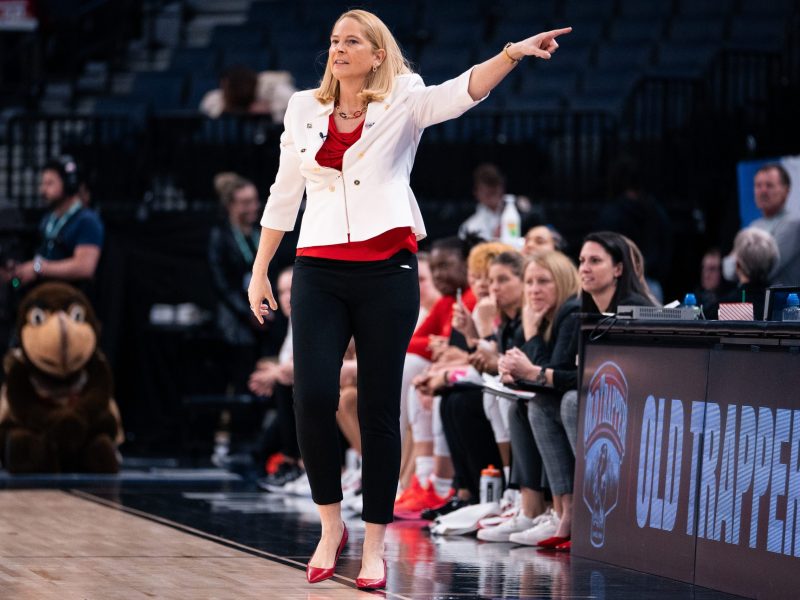Reese McClure executed an impressive flip on the balance beam, landing back on the four-inch-wide surface on just one leg. But her balance was off-center, and Maryland gymnastics faced another deduction in the first half of the Iowa Tri-Meet against the Hawkeyes and Minnesota Golden Gophers.
And the Terps’ beam struggles didn’t end with McClure. Maryland’s lineup failed to reach the 9.80-point mark on the apparatus, registering a 48.65 — its worst beam showing since the Rutgers Tri-Meet on Jan. 23.
It was an uneven day for coach Brett Nelligan’s squad, which left itself in a big hole following poor showings on bars and beams in its first two rotations. But, following some late fireworks on floor and vault, Maryland found itself with a new season-high, earning a 195.35 Saturday afternoon.
“I think we just started slow… We were a little tight,” Nelligan said. “I thought with each event our intensity increased, and you saw at the end vault was on fire.”
[Maryland gymnastics gets loud in practice and even louder at meets]
The Terps kicked off their afternoon on the uneven bars, their worst event this season. Aleka Tsiknias led off the lineup with a fall on her dismount, and both sophomore Sophia LeBlanc and freshman Olivia Weir followed up with scores of less than 9.60.
Maryland found some bright spots in the second half of its bars lineup, as freshman Tayler Osterhout notched a 9.70 in her NCAA debut and senior Audrey Barber posted a 9.85. Still, the Terps fell well short of the vaunted 49 mark on the apparatus, earning a 48.425.
“We kind of survived that rotation, but that wasn’t our plan, that’s not what we came to do,” Nelligan said. “We came to thrive, not to ride.”
The gap between Maryland and its Top 25 opponents would continue to widen in the second rotation. A strong leadoff performance by senior Collea Burgess gave Nelligan’s squad hope of turning things around. Burgess notched a 9.775, tied for her second-best score in the event this season.
But, only Barber and senior Sabriyya Rouse would post scores above 9.70 on the beam, with a litany of small inconsistencies proving fateful as Maryland toiled to a 48.65 in the event.
Despite their early struggles, the Terps continued their dominance on floor this season in the third rotation; they came into Saturday’s meet ranked No. 11 in the nation on the apparatus. Maryland didn’t record a score below 9.725 on Saturday afternoon. Burgess was the standout, leading the Terps with a 9.90 — her season high. Barber added a 9.85 from the anchor role, and Nelligan’s squad cruised to its fifth 49 on floor.
It served as a turning point for the Terps as they gained some needed momentum heading into their final rotation on vault.
“Being able to dance to our teammates’ routines and really get into it always picks up the energy for us,” Burgess said. “That really turned it around and gave us that motivation, that drive, to really finish the meet.”
[Olivia Weir has impressed for Maryland gymnastics in her freshman season]
And Maryland looked revitalized on the apparatus. McClure and sophomore Emma Silberman set the stage for an impressive display, notching dueling 9.85s to leadoff the lineup.
The rest of the Terps’ lineup mirrored the sophomores’ energetic displays, helping push Maryland to a 49.175, its highest vault score of the season.
“Our energy improved after floor, or even just during floor,” Barber said. “That kind of just brought home the rest of the meet.”
The Terps’ performances on floor and vault were enough to propel them to their season-high score of 195.35. Still, the No. 9 Hawkeyes and No. 12 Golden Gophers were too much to overcome as Maryland slipped to 3-4 on the season.
Nelligan’s squad will look to overcome the missteps it faced on bars and beam going into next Friday’s meet against Michigan. Those two events have been walls on the Terps’ scores this season, but ones they think they can hurdle.
“I still feel that we haven’t hit a full meet how we know we can,” Barber said. “Focusing on the little details … like wobbles here and there, and handstands, and just more stuck and controlled landings, that’s what we’ll be working on.”



